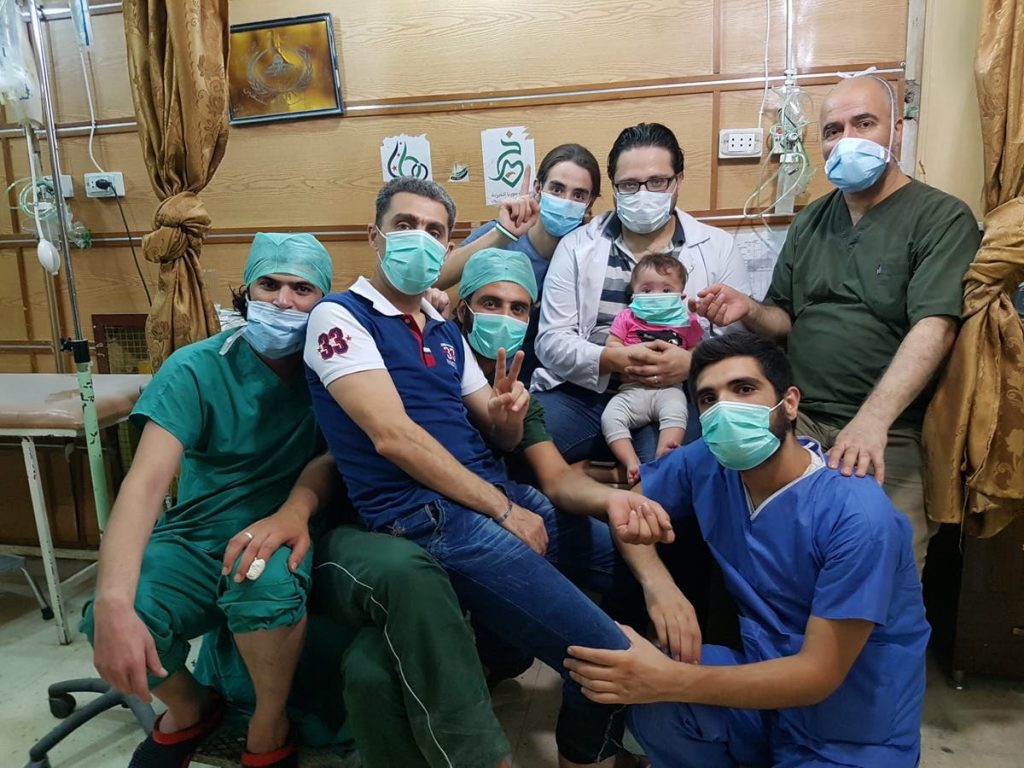In a new precedent, two Syrian documentary films, “For Sama” and “The Cave,” have been nominated for Best Documentary Feature in the 92nd Academy Awards. Though filmed in two different cities, in separate hospitals, and featuring different people, both tell a hauntingly similar story of health care under systematic attack by Syrian government forces and their allies. In both films, the voices of the female protagonists are disrupted repeatedly by the sound of bombs, screams, and tears; but these are juxtaposed with scenes of courage, hope, and laughter. Audiences have been awed by the resilience of the Syrian people, and most specifically the resilience of the health care workers in a country torn apart by the devastation of war.
“For Sama” tells the story of a young Syrian woman, Waad al-Kateab, her marriage, and the birth of her daughter, Sama, in Aleppo. Shooting between 2011 and 2016, Waad’s camera captures the escalating suffering of the Syrian people: from the streets, where Syrian government authorities deploy lethal force against peaceful pro-democracy protesters, to the fortified hallways of al-Quds Hospital, where Waad’s husband, Dr. Hamza al-Kateab, works day and night to provide medical care for people wounded in the seemingly endless bombardments by Syrian government and Russian forces.
“I felt guilty. I was making my family live in the most dangerous area in Aleppo – the hospital was the biggest target.”
Dr. Hamza al-Kateab
The gut-wrenching scenes show the hospital under repeated attack while exhausted doctors do the best they can just to keep the injured alive. It is these attacks that are the focus of PHR’s new case study, Al-Quds Hospital – The Last Hospital Standing in Aleppo. This research demonstrates the magnitude of attacks on hospitals in Aleppo, including the one where the “For Sama” protaganists, Waad and Dr. Hamza, are forced to live and raise their first child. During the period leading to the final offensive on Aleppo, PHR documented 10 Syrian government or Russian attacks on five hospitals that were repeatedly targeted until they were put out of service. Additionally, PHR verified three attacks on al-Quds Hospital that caused significant damage and disrupted medical activities.
Dr. Hamza told PHR: “I felt guilty. I was making my family live in the most dangerous area in Aleppo – the hospital was the biggest target.” Yet, with his colleagues, they continued to provide care until they were forced to evacuate after the Syrian government regained full control over the city in December 2016.

After bombing and starving Aleppo and its civilian population into submission or exile, the Syrian government used the same tactic in the Damascus suburb of Eastern Ghouta. There, doctors and nurses alike had to endure multiple military offensives, treat the wounded, and conduct surgeries with very scarce resources due to a suffocating siege.
This is where we find the protagonist of “The Cave,” Dr. Amani Ballour. Dr. Amani and her colleagues operated the Cave Hospital, an underground facility in Kafr Batna, in Eastern Ghouta, and remained there until they were forced to evacuate in February 2018. Directed by Firas Fayyad, “The Cave” walks us through the daily ordeals of Dr. Amani and her colleagues, who balance the hourly challenge of trying to keep their patients alive with their own survival while under unrelenting bombardment.
From the start of the Syrian conflict in 2011 until April 2018, PHR documented 57 attacks on 45 health care facilities in eastern Ghouta; in its latest case study, At Syria’s Cave Hospital, Conducting Surgery under Bombardment and Siege, the research zeroed in on the impact of these attacks on the Cave Hospital. According to Dr. Amani, “We were hit countless times, we even stopped counting the small hits because those became a normal part of our lives – the building would shake, we would pause for few minutes, and then resume our work.”
On its interactive map, PHR documented four attacks on the Eastern Ghouta hospital, one of which lingers heavily in the hearts of those who worked in the hospital. In the words of a survivor, “the missile from that attack penetrated the first floor and exploded in the inpatient care unit in the building’s basement.” That attack killed four hospital staff members – two nurses, the administrative manager, and an ambulance driver.
“We were hit countless times, we even stopped counting the small hits because those became a normal part of our lives – the building would shake, we would pause for few minutes, and then resume our work.”
Dr. Amani Ballour
Intentionally targeting hospitals is a war crime, and one of the most profound violations of ethical, moral, and legal norms and obligations under international humanitarian law and customary international law. The stories of Waad, Dr. Hamza, Dr. Amani, and their colleagues provide the barest glimpse into the many instances of heroism in the face of the near-incomprehensible brutality and tragedy that PHR has been documenting since the start of the Syrian conflict. As the fighting enters its ninth year, we hope these powerful films will remind the world of the terrible human cost of the ongoing conflict in Syria and spur meaningful international action to put an end to the impunity that allows these horrors to continue.
Images courtesy of “For Sama”

